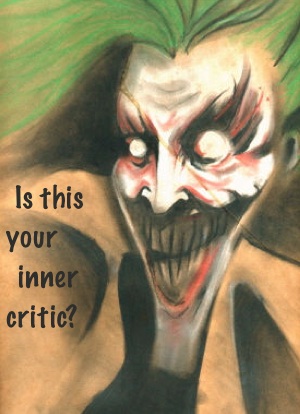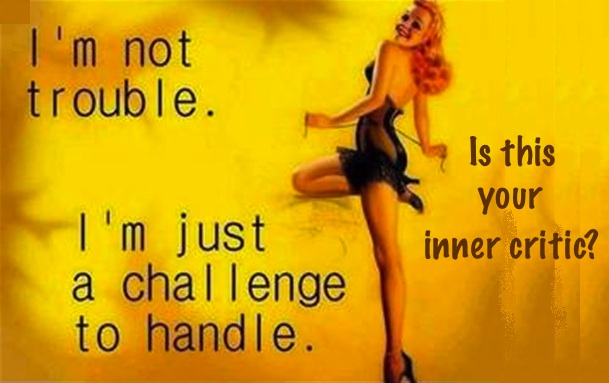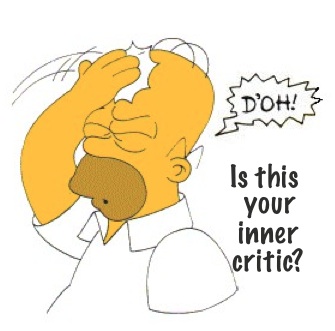Posted on September 10, 2013 by Leah Mazzola

Photo credit: greensong on Flickr
What is the inner critic?
The inner critic is an automatic critical thinking process that continuously evaluates how our actions mirror our values, thoughts, and beliefs. It then draws inferences for learning and survival. We all have it.
Photo credit: M1k3
- Action
- Observance
- Adjustment
When it turns nasty: how to spot an overactive inner critic
Besides its furling talons and curlicued whiskers, the unfettered inner critic is easy to spot. It leaves a stench of low morale and general bad feelings. The gloom it leaves in its wake is brought about by a combination of negative self-talk, negative self-concept, low self-esteem, excessive feelings of guilt or shame, an inability to forgive the self, or perfectionist tendencies.
Photo credit: marsmet472 on Flickr
What’s its poison?
An inner critic on a caffeine-high has many blind spots. Here is one practice you can incorporate to overthrow the unwelcome blasphemer in your inner church.Acceptance and Commitment Therapy (ACT)
ACT is a mindfulness-based and values-driven behaviour therapy. At the bedrock of this approach is an attitude of acceptance over that which you have no control (e.g., your thoughts and emotions will be annoying at times), coupled with a commitment to act in a way that improves and enriches your life. Mindfulness and defusion (which is the act of putting space between the self and negative thoughts and feelings) are the active techniques espoused by ACT. Its core strategy is to employ mindfulness. The automatic, spontaneous nature of the inner critic means it can exist without our attention. But if we become attentive we can determine whether it is working for or against us. It’s useful to think of the inner critic and mindfulness as tools in a toolkit. A tool must be well maintained to function when needed. All tools serve a purpose, but without a professional who knows how to use the tool, it is ultimately redundant. We must become familiar with our stash of inner tools so we can know when to use them and when to put them away. If a doctor were to hold a stethoscope in one hand while attempting to carry out all daily duties, the tool would become cumbersome and get in the way of efficiency. It would likely cause more harm than good for both the doctor and patients.ACT Step 1: Stop and notice
Ask yourself the following four questions and write your answers down (you can download a printable version of this exercise below — it’s free):- What kinds of things do you tend to say to yourself when you are unhappy with your result or actions in a situation? Examples: “I can’t believe I did that,” “What is wrong with me!?,” “That was not very bright,” “Why am I so dumb!?,” “Why can’t I just get it right!?”
- Is there a particular scenario that you tend to have more difficulty with or be harder on yourself around (e.g., school, work, or relationships)? Example: I notice I lose my temper easily when I’m stressed and then become really hard on myself which tends to put me in a funk. What kind of feeling is associated with becoming hard on yourself? Example: Shame, guilt, anger, sadness.
- How do those feelings affect you? Example: I don’t really want to be around people. I don’t trust myself not to react the wrong way when I’m stressed out, so I get really nervous and anxious when I have to deal with other people — which just stresses me out more.
ACT Step 2: The inner critic makeover
It is imperative to create space between you and your inner critic so you can move away from the negative thought patterns and subsequent bad feelings it creates. Otherwise, we can become attached to its irrational thought processes and eventually identify with them. A simple method is to create an entity around your inner critic to symbolize the tool that it is. This allows you to recognize it when it shows up, determine if it’s helpful or not, and then decide what to do with it.
Using your answers to questions 1 and 3, create an entity to suit. Give your inner critic a name, a colour; dress it. Why not create a funny cartoon character with a big nose and small mouth? Does it have bad breath? Floppy ears? Think about size — and remember: small is good, tiny is better. This is an entity you intend to tame.
In question 2 you identified some situational and emotional triggers to alert you to the presence of your inner critic. And now that you have it nicely packaged and named, you can choose what to do with it when it starts to cheep and chatter.
Ask yourself if its presence is helpful. Why is it or why is it not? Do you want to check the information it brings, then send it on its way? Each time it appears, the appropriate action will be different depending on the situation.
The point is awareness — and limiting the havoc your inner critic can wreak on your well-being through conscious, healthy use.
A simple method is to create an entity around your inner critic to symbolize the tool that it is. This allows you to recognize it when it shows up, determine if it’s helpful or not, and then decide what to do with it.
Using your answers to questions 1 and 3, create an entity to suit. Give your inner critic a name, a colour; dress it. Why not create a funny cartoon character with a big nose and small mouth? Does it have bad breath? Floppy ears? Think about size — and remember: small is good, tiny is better. This is an entity you intend to tame.
In question 2 you identified some situational and emotional triggers to alert you to the presence of your inner critic. And now that you have it nicely packaged and named, you can choose what to do with it when it starts to cheep and chatter.
Ask yourself if its presence is helpful. Why is it or why is it not? Do you want to check the information it brings, then send it on its way? Each time it appears, the appropriate action will be different depending on the situation.
The point is awareness — and limiting the havoc your inner critic can wreak on your well-being through conscious, healthy use.

Negative internal self-talk can become a game stopper, a life stopper.
Additional things you can do to help quiet the inner critic is to look at what worked in your day. Create a gratitude journal and reflect on what went well. If you drive to work and did it without an incident, then write that down. Notice what is working.
All to often we only look at the things that went wrong and those become the objects of focus. The “news” is attractive because it activates our fear sensors and our bodies are tuned to recognize things that are going wrong or are bad. Turn off the TV and do something that creates positive thoughts and outcomes.
Practice self-compassion (www.self-compassion.org) and develop a set of habits that will help you kick the habit of negative internal self-talk. Bring yourself up rather than down and see how you feel. Practice yoga or meditation and see how that can reduce the stress in your life.
The inner critic needs a new job and you can help that critic by feeding it positive content. Pretty soon life will look better, you’ll feel better and you’ll get better results.
Another name for the inner critic is gremlins, those voices that tell you you’re not good enough or smart enough at times. When you find yourself calling yourself a jerk, stupid, ugly, and other lovely names you are repeating things you heard when you were younger that you were called by those in authority over you. It’s not easy to recognize or stop these self-defeating patterns as author, Leah Mazzola, mentions in her blog. I agree with step 1 of the ACT process to stop and notice and make note of the times you fall victim to these gremlins. However, I don’t think it’s so easy to put distance between you and your gremlins without taming them first, literally by telling them to just shut up, who invited you to comment on my party? Who’s in charge here? Also, some self reflection is in order to recall who said these things to you, when and why? When did you first hear these words? You didn’t start calling yourself stupid, you learned to call yourself stupid, someone taught you those words. By understanding that this is a conditioned reflex and not the authentic wonderful you, then you will be able to create some distance between that inner critic and you.
Thank you Leah for choosing such an important topic.
I personally practice and also teach my clients to use their inner negative self -voice to change their limiting beliefs.
For example: When we tell ourselves “what you did was stupid†“you never make things right†and only if such statements make us feel bad, I asked myself
“What do I need to believe to feel this way�
Usually the answer is “I am not good enough†or some version of it.
That can be a core belief itself but it can as well lead to a deeper core belief like:
“If I am not perfect, I won’t be loved†or “if I am not loved, I am not worthyâ€Â
That concludes step 1: acknowledge and accept your limiting beliefâ€Â
Step 2 would be to deliberately change it by brain-washing yourself with a positive empowering belief that will replace the limiting one:
“I don’t have to be perfect to be loved†and “I don’t have to be loved to be worthyâ€Â
Just by repeating these new beliefs, you start to neuro-reprogram yourself and the negative self-talk gradually decreases.
“LIFE” happens…and seldom at a time of our choosing.
What are the things in your daily waking life do you really have control over? What are those things that you don’t? Have you ever really stopped and thought about it? In my experience and opinion, it will be worthwhile it to ask yourself these questions.
A person’s inner critic can quite possible be their worst nightmare. What makes me think this is the fact that what is created, or shall I say, what we conjure up in the subconscious mind will typically outweigh the conscious mind. Our deep, critical thoughts usually start in the subconscious mind. Therefore what we think about subconsciously usually will manifest itself. A person’s “Right” brain deals with the subconscious thoughts, whereas the “LEFT” brain deals with the conscious thoughts. I have found that if a person utilizes both the “RIGHT” and “LEFT” brain, the chances of getting the results that you desire are increased.
A good way to defeat the A.N.T.s (Automatic Negative Thoughts) that we have on a daily basis is to consciously “override” those thoughts. What do I mean by this you ask? Here is what I mean, let’s say you are sitting at your desk at the office, you’re not real busy, your mind starts to wander. In a lot of cases the mind tends to automatically wander towards negative thoughts instead of positive thoughts. When you find yourself thinking (focusing) on a negative thought, override it (start thinking about anything positive, and while you are thinking about that positive thing, feeling, visualize that positive thing that you are thinking about). In addition tell that negative thought to go away. Say it out loud, otherwise it will make no difference.
Know that your inner critic is not always your enemy, only those times that you allow yourself to be overly critical of yourself, by “accepting” too much non constructive criticism. Constructive criticism usually is a good thing, whether it’s coming from you or from someone else. Learn to differentiate between constructive criticism and non constructive criticism. Accept the constructive criticism and use what you can, discard the rest. As for the non-constructive criticism, replace it immediately with positive thoughts and focus on those positive thoughts throughout the day, and describe out loud to yourself what those positive thoughts are. You will find that engaging your body and mind will likely create better results for overcoming any negative thoughts that you may have.
“L.I.F.E.” — L…iving I…ndescriminately, while F…orever E…volving.
For a free short inspirational mp3 recording that you can listen to daily , please email me. On the subject line write “Free inspirational recording”. There are two to choose from. One is titled “L.I.F.E.” and the other is titled “Peace”. Both recordings are less than 5 minutes. Please indicate which you would prefer. I will email the preferred mp3 to you within 48 hours.
Health, Wealth, and Prosperity to you.
Noticing your inner dialog can be an enormous challenge as those thought patterns have been built up with years of practice and are often so ingrained as to be unconscious.
To help bring these patterns to light and to help change the language you use internally you can start by noticing how you talk about those around you. That’s right, you’re inner critic is doesn’t just criticize you, it is also at work on your friends, your co-workers, the person who cut in front of you on the freeway…
That external critic is a reflection of your internal dialog in one of two ways. The first is a direct, if not somewhat muted form of what you say to yourself. Notice when you have extreme judgments about someone and ask yourself some of the same questions that are in step 2 and step 3 above. Then ask yourself when you might have that same kind of reaction to yourself.
The second, is a complete inverse of your internal dialog. In that case, notice when you have a flash of irritation about someone, but then give them the ‘benefit of the doubt’. Do you ever give yourself the benefit of the doubt? Why are others more deserving of that thought process?
Finally, the inner critic feeds on absolutes. Smart or dumb, black or white, succeeded or failed. Changing your perspective to focus on effort rather than outcome can go a long ways towards taming the inner critic. Read the book, Mindset, by Carol Dweck Mindset: The New Psychology of Success for an in-depth discussion on that topic.
The time honoured maxim “What you resist persists” is most relevant to the inner-critic. Overriding or brainwashing ourselves with happy thoughts is merely swapping a negative polarity for a positive and counter productive to our integration as complete individuals. We must hold both polarities with equal respect to create the space for truly transcendent ideas and feelings; breakthroughs; to emerge. As coaches compassion is our key meta skill and this comes from knowing ourselves as victim and perpetrator.
I keep it really simple with the inner-critic. All negative beliefs and resulting assumptions are a cry for attention and exploration from undifferentiated or unconscious parts of the psyche. Essentially a plea for unconditional love. As Jung discovered until we make the unconscious conscious it will show up in our lives as fate. It is therefore essential to follow the feelings and allow our true selves to emerge out of that process. Jung felt worthless after Freud’s rejection and completely regressed spending months building forts in his garden and behaving like a little boy. It is his humility and this process he went through that we have to thank for Jungian psychology and the resulting methodologies that have sprung from that. If Jung had not allowed himself to feel worthless and just brainwashed himself with happy thoughts that never would have happened and the world would have been deprived of the most in depth perspective on the human psyche ever formulated.
The other essential point with regards to the inner-critic concerns emotional intelligence. As an individual I must be able to differentiate between healthy shame and toxic shame. To take the example of a bad investment – healthy shame supports us to see more research will pay and motivates us to learn from the mistake. Toxic shame triggers untrue limiting assumptions about our entire being. “I’m not good enough, I’m stupid” etc.
as the essence level when all the jargon is rendered irrelevant, self-love remains the irrefutable answer and the inner-critic our most trusted ally for pointing out where we need it most.
@dan : great supplement! you are going to love our happiness and work infographic when it goes live: the three things that you are grateful for today is profiled!
@cheryl : agreed! it take a certain level of strength and sure-in-my-shoes-ness to start reconditioning your powerful brain!
@gabriela : i am so glad you are stepping your clients through this important work. beliefs and brain-washing.
@angela: ‘when your inner critic is your worst nightmare’ is a great quote. i feel like there is a follow-up case-study article there…what do you think?
@kenneth baker : thanks for pointing us to ‘Mindset’ as a resource, it looks like a great one! the inner critic DOES love absolutes indeed! sweeping generalizations are dangerous but focusing on your EFFORTS rather than OUTCOME is a great step in the right direction.